Is it a fourrée? How can you
tell?
By definition, a fourrée is
made
from a base metal core covered with silver foil and struck to look as
if
it were solid silver. Some pieces are easy to identify as
fourrées,
but many pieces with some characteristics of fourrées are not
actually
fourrées.
It is a fourrée if
surface patches of surface-silver are clear and
patches of coppery metal are clear below breaks in the silvering and
the
edge of the break shows a firm line of distinction, as if the base flan
had been wrapped in foil and the foil had broken.
It is not necessarily a fourrée if
surface patches of silver are clear and it has
patches
of darker metal, or pits with darker metal, or design chipped off with
darker metal below.
There is a metallurgical reason that official "silver" issues can
have
both good silver on the surface and baser metal inside. During the
Republic
and early empire when denarii were more than 90% silver, this does not
happen. But, under the Severans when "silver" coins were only about 50%
silver or less, the striking process squeezes the malleable silver to
the
surface (especially if the flan has been pickled in an acid bath first)
and leaves the interior relatively base. An article by Lawrence Cope,
"Surface-silvered
ancient coins" in Methods of Chemical and Metallurgial
Investigation
of Ancient Coinage (Ed. Hall and Metcalf, 1972) states "Electron
probe
micro analysis .. [reveals that] 'platings' of this era are not applied
but they stem from the coinage alloys themselves" (p. 266). [The
article has numerous illuminating diagrams of alloys and several plates
of microphotographs of coins. It discusses the entire range of
surface-silvering
processes.] He notes that copper alloys up to 85% copper will produce a
satisfactory surface-silver layer by the normal process of minting (p.
269). You have probably noticed that the surface silver of a Septimius
Severus or a Philip can look great, even though the metal is far from
pure.
Even the early issues of Gallienus (with silver content down below 20%)
can look like silver without an applied surface silvering. The high
purity
on the surface is balanced by low silver content in the interior. But,
there will be no firm line of demarkation. Keep in mind that
fourrées
were made with silver foil and the line between the silver and the
copper
is distinct.
Therefore, a good silver surface and a baser interior is not
a sure sign that the coin is an ancient imitation.
Images link to larger imges,
but
not to further text.
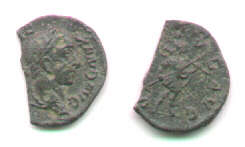
 Severus Alexander denarius, cleanly cut (in antiquity?)
Severus Alexander denarius, cleanly cut (in antiquity?)
18 mm. 6:00
[....]LE-XAND AVG
/V[...]VS AVG
Sear 2241, RIC 224 "scarce, AD 228-231", BMC 522, plate 18, mint of
Rome, issue 9, AD 229.
This piece shows no surface silver, and even the pits show only dark
metal. Examination of the surface under a microscope does not reveal
obvious
silver. So, one might conclude it is some sort of base metal imitation.
However, the style seems official. Turning to the edge, microscopic
examination
under 20x shows a shiny silver color (not obvious in the scan) from
edge
to edge, with no differentiation through the thickness of the coin. I
conclude
it is an official issue of the usual debased silver of the period, with
corrosion erroneously suggesting a baser metal.
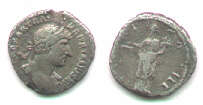

Hadrian, AD 117-138, denarius with metal missing at 12:00 on the
obverse.
IMP CAESAR TRAIAN HADRIANVS AVG
/PM TRP COS III, Aequitas holding balance left,
RIC 80, AD 119-122, Sear --.
The missing metal at 12:00 looks corroded off (as
opposed to fractured off) and the deeper metal is baser and has hints
of
coppery color. But the coin does not show the distinct edge of a silver
of a silver-wrapped copper flan. It is not a fourrée.
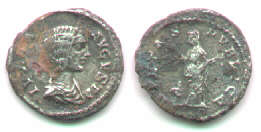
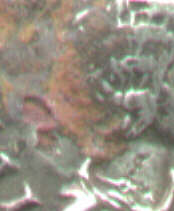
Julia Domna, denarius, AR 18, 6:00
IVLIA AVGVSTA
/PIETAS PVBLICA, Pietas standing left over altar
raising both hands
Sear 1847, BMC (S&C) 70, plate 28.15, page 166 "AD 196-211."
The surface shows obvious copper and the pits show copper beneath the
silver. However, the style is very good. Microscopic examination shows
a highly grannular interior (I wish I had a way to make a micro scan),
and even a change from surface-silver to a redder core. But I think
this
is just the natural result of striking an alloy of only 50% silver or
less,
as Cope discussed (above). When silver plating breaks, the break is
usually
much less subtle than this.
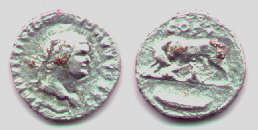
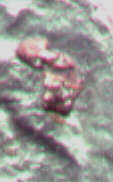
Domitian, denarius, AR18, 6:00. 2.29 grams.
CAESAR AVG F DOMITIANVS, counterclockwise, outward around laureate
head right
/COS V above wolf left and twins, boat below
The copper is clear, but is it fourrée? Close inspection under
a microscope shows the copper is on the surface -- actually above
the surface, not below the surface. The piece was harshly cleaned and
it
came out shiny, but the cleaning did not remove all the adhesions. I am
not a metallurgist, but I think the copper leached out of the coin (it
probably had 10% copper in the alloy). My guess is this is an official
issue. The light weight is often a sign of an unofficial issue, but
here
I think it means that much of the metal in the interior has corroded --
even corroded away.
Sear 2621, RIC (Vespasian) 241, AD 77-78. BMC (Vespasian) 240-1, plate
7.8, 7.9.
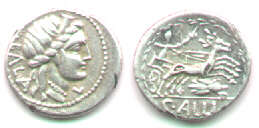

Roman Republican denarius type, 92 BC
C. Allius Bala, Aelia 4
Crawford 336/1c, with L/fly as attested on page 337.
Female head right, wearing diadem, BALA behind, L below chin
/Diana in biga of stags right, fly below, C.ALLI
in exerge
This piece is in excellent style, with the reverse a tiny bit crude,
but hardly more so than many Republican reverses. Only the very clear
breaks
in the silver show the base core of a fourrée. Examination at
20x
shows there is a foil-like surface that has broken on these high
spots.
It is a fourrée.
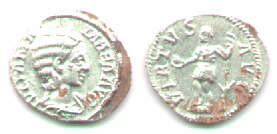
Julia Mamaea (mother of Severus Alexander, d. 235), fourrée
denarius, 18-19mm, 6:00
Here the silver-foil is clearly differentiated from the copper interior
which breaks through at the edge and in other places. The silver is
clearly
on the copper, not the copper on the silver (as sometimes happens due
to
expansive
corrosion of the copper component of the interior of a official silver
coin). Also, the style is not official, which is a strong indicator it
is an imitation. This one is clearly a fourrée.
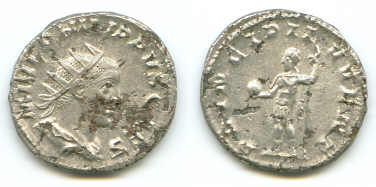 Philip II as Caesar (AD 244-247) 21 mm. 12:00. 3.77 grams.
Philip II as Caesar (AD 244-247) 21 mm. 12:00. 3.77 grams.
This one is a real puzzle! The style is perfect and the coin is
struck
and sharp. I would call it certainly official except for one obvious
thing -- there appear to be regions of copper below a thin (but not
extremely thin) surface layer of silver. The surface-silver seems to be
in a distinct layer, and the metal below is without visible silver --
so it is a fourrée (isn't it?). But, how did a fourrée
turn out to have such
perfect style?
Can we decide that official mint workers made it?
Or, is the silver
in this time period of such low fineness that the separation of
surface-silver known to occur when coins are struck produced this
extreme example? I have held this one for almost a year before putting
it up on this site becaue I just don't know what to think.
Return to the main page on imitations.

 Severus Alexander denarius, cleanly cut (in antiquity?)
Severus Alexander denarius, cleanly cut (in antiquity?)









 Philip II as Caesar (AD 244-247) 21 mm. 12:00. 3.77 grams.
Philip II as Caesar (AD 244-247) 21 mm. 12:00. 3.77 grams.